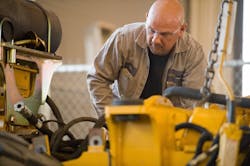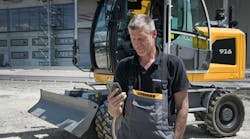Construction equipment drivetrain systems have evolved to meet the needs of today’s customers. OEMs continue to develop systems that deliver better efficiency, higher performance, higher durability and improved operator comfort. As a result, new technologies such as diesel electric hybrids, continuously variable transmissions, high-efficiency hydrostatics and electronically controlled powershift transmissions have been developed. Although the type of transmission varies due to the wide disparity in construction equipment machine forms, what is common is the importance of avoiding downtime. Downtime can best be avoided by implementing solid maintenance plans to ensure the needs of equipment managers are met over the life of the machine.
Diesel electric hybrids, continuously variable transmissions and electronically controlled powershift transmissions utilize gears, bearings and clutches to transmit power from the engine to the wheels or tracks. These components need to be properly lubricated to ensure long life and efficient operation of the system. High-efficiency hydrostatic drive systems involve a hydrostatic pump that produces a high-pressure oil flow that is converted back to mechanical rotation in the hydrostatic motor. These systems have tight clearances and are particularly dependent on the proper viscosity and oil cleanliness. Many continuously variable transmissions combine a hydrostatic drive system with a mechanical power path to transmit power to the wheels. Electric drive systems still utilize gears and bearings to convert the mechanical power of the electric motor to match the torque and speed requirements of the traction drive or other usage of the electric power. Many electric drives also use the oil to cool the electric motor and generator.
The lubricating ability of the oil starts with the base oil quality or base stock. Modern oils are primarily composed of API Groups II and III base stocks with a limited number of customers using Group IV synthetic base stocks.
The base oil is just the start of the lubrication package provided by modern drivetrain lubricants. Anti-wear and extreme-pressure additives are added to the base oil to reduce component wear. These anti-wear additives are especially important to the lubrication of gears and bearings that will have metal-to-metal contact. The lubricating oil prevents metal-to-metal contact that would otherwise damage these components.
Powershift transmissions utilize friction clutches to change the power flow from one ratio to another within the transmission. Friction modifiers are added to provide smooth clutch operation in powershift transmissions and reduce chatter in braking systems.
Viscosity modifiers are added to maintain a tighter range of viscosity over the operating temperature range of the oil. These additives tend to increase the viscosity at high temperatures and lower it at colder temperatures to provide the necessary fluidity to pump the oil at cold startup.
The oil-circulating systems of most modern transmissions have a high flow rate for lubrication and cooling, which can lead to oil aeration. Too much entrained air can reduce the oil’s lubricating properties and prevent it from being able to carry heat out of the transmission and to the coolers present in the system. Foam suppressors are often added to help the oil expel the entrained air more quickly.
The oil sump of most transmissions is open to the atmosphere through a breather system, so moisture from the outside air can collect in the oil sump. Gearboxes that do not reach operating temperature can accumulate moisture over time, which can damage the system. Rust and corrosion inhibitors are added to protect the internal components from the damaging effects of this moisture.
Most gearboxes contain elastomeric seals that can be affected by the chemicals in the oil. The oils must be tested so that they do not react with the elastomers and cause cracking, shrinkage or hardening.
In hydrostatic systems, the oil is the fluid that transmits power from the pump to the motor. It also functions to lubricate the internal parts and to remove heat from the system. Some hydrostatics have a separate oil system, but many share the oil sump with the transmission or other function of the vehicle.
Viscosity is important to the operation of a hydrostatic system. If the viscosity becomes too low at high temperatures, the leakage in the system can increase and a reduction in system efficiency will be noticed. Too high a viscosity can cause the system response to be sluggish and cause the temperatures to increase from the added pumping losses.
Oil cleanliness is important for hydrostatic systems, as the internal clearances are tight. Debris particles in the oil can cause wear in these areas of tight clearance, which leads to leakage and poor performance. They will ultimately cause a reduction in the life of the components, increasing the probability of equipment downtime. Adding oil to a hydraulic system with a dirty bucket or funnel wiped out with a rag is not a good practice, as it will introduce contaminants into the system. A pump and filter is recommended when adding new oil to the hydrostatic system reservoir. Regular monitoring and maintenance of filters in the system will also help maintain the intended system performance.
Even with high-quality base stocks the oil will become oxidized through heat and moisture exposure. Oxidation inhibitors are added to slow this process of oil breakdown. The rate of oxidation increases with oil temperature, so it is important to control this by keeping coolers clean and free of debris, and to operate the equipment in such a way so extreme oil temperatures are avoided.
Proper selection of the oils for the intended application and maintaining the condition of these lubricants can go a long way in increasing the lifespan of the drivetrain components. Oil condition can be maintained by adhering to the equipment manufacturer’s oil change schedule or by condition-based maintenance described later in this article.
Telematics and maintenance
Machine health prognostics are about being systematic. It’s about being process-oriented and using statistical analysis in conjunction with today’s telematics systems to improve machine reliability. We must first understand the history of the machine health journey to understand the creation of machine health prognostics. Let’s focus on three types of maintenance approaches used today within the construction industry.
The first approach is reactive maintenance. In reactive maintenance, fleet managers or machine owners do not utilize any form of proactive machine health techniques. They simply wait for things to fail and react by focusing on the repair. This approach does not allow the user to plan ahead to schedule repairs or component replacements when they are more convenient. Reactive maintenance practices are the most expensive maintenance practices.
The second approach is planned or scheduled maintenance. In this type of maintenance approach, the fleet manager or machine owner utilizes some proactive machine health techniques and is able to prevent many failures and downtime. With this approach, the user focuses more on following the manufacturer’s recommended maintenance intervals rather than the conditions of the machine in its operational environment. Fluids and filters are changed in accordance to manufacturer’s recommended maintenance intervals.
Planned or scheduled maintenance helps protect operations from the expense and stress of catastrophic failures, while letting you avoid waste-disposal hassles so you can focus on job productivity and profitability. On-site planned maintenance service is performed where and when needed. Many of the benefits of participating in a planned maintenance agreement include:
- Increased uptime and convenience. Maintenance can be performed at night or on weekends when the machine is not in use. Also, problems are found before they cause breakdowns, allowing repair work downtime to be scheduled.
- Cost-effectiveness. Problems are discovered in their early stages and “fixed before failure,” while they are still minor repairs, before they affect other machine parts and become costly, major repairs.
- No unexpected costs. The price of the planned maintenance service, including all parts, labor, equipment, supplies, lubricants, etc., is usually established at the signing of the agreement and therefore fixes costs over the life of the agreement.
- No EPA worries. Hazardous waste materials are disposed of properly by the service technician.
- Quality parts and technicians. Factory-trained technicians perform the maintenance work using quality products (genuine OEM oils, filters, etc.).
- Longer machine life. Regular maintenance increases the life of the machine.
- Increased equipment value. Detailed maintenance, repair and oil analysis records are kept on the machine, increasing its value.
The third approach is condition-based maintenance. In this type of maintenance approach, the fleet manager or machine owner works on eliminating the root cause of failures and utilizes various data and analytics resources to anticipate the needs of the equipment to avoid failures. In this approach, trending fluid analysis data is used to determine the required fluid and filter change intervals. To ensure success of this approach, fluid sampling best practices should be utilized. In addition, the trending data provides visibility and insight to component life projections that help indicate when to rebuild or replace major components. The owner can not only plan ahead and schedule most of the repairs before they turn into a major failure, but also benefit from extended component life and savings through the utilization of a systematic approach.
As the industry focuses on uptime and lowering operating costs, it’s important to understand all of the factors that affect owning and operating costs. “In a 1985 ASME study, ‘Progress and Payout of a Machinery Surveillance and Diagnostic Program,’ J. Hudacheck and V.R. Dodd established that the cost of reactive maintenance is twice more than that of conditioned based maintenance.” Simply following the scheduled maintenance plan of a machine is not enough to fully maximize reliability and minimize owning and operating costs.
Machine health prognostics combine telematics data, preventive maintenance information, fluid sampling and analytics to provide actionable solutions to equipment managers. It is taking condition-based maintenance to the next level by automating the collection of data, interpreting the data and sending an actionable communication to ensure machine reliability.
Repair, recondition or reman?
You can maintain transmissions, but machines age and equipment managers are ultimately faced with the following question: “When is the best time to repair or reman my machines?” Reman programs provide customers with high-quality, expedient and economical repair solutions when a major component experiences a failure. But before we go any further, let’s distinguish the three levels of repair:
Remanufacturing
- Involves complete disassembly of the component
- Replacement of all wear components (such as bearings and seals)
- Replacement of all failed components
- Tested at new performance specifications
- Supported by a comprehensive manufacturer warranty
Reconditioning
- Limited disassembly
- Replacement of failed components and some wear components
- Limited performance testing
- May or may not carry a warranty
Repair
- Disassembly to the point of failure
- Only failed component is replaced with new or used parts
- May or may not carry a warranty
Remanufacturerd components will meet or exceed new performance specifications; reconditioned or repaired components may not. Equipment managers can expect the same level of performance and durability from a reman component as they can from a new component. If any updated parts are available, the manufacturer should replace those parts with the latest version to ensure the customer benefits from those design changes. In some cases the reman component may outlast the original component.
Many manufacturers operate their reman programs on an exchange model, where remanufactured components are stocked in their distribution system. This minimizes downtime to the customer because when a failure occurs, the dealer can order a replacement component and simply swap out the failed one. This gets the machine back up and running in the shortest time possible.
Reman components are typically priced at 60 to 75 percent of new parts, so the customer can get the same level performance and durability at a significantly lower price point. They may also come with some type of warranty that provides added peace of mind to the customer.
Remanufacturing also supports many green initiatives by maximizing the reuse of failed components. It also ensures that components that cannot be reused are properly recycled to minimize the amount of material that ends up in the landfill.
As construction equipment drivetrain systems continue to evolve, it’s vital that equipment managers keep tabs on the newest technologies and methods for maintaining their fleet. Transmission maintenance is only part of the equation, but an extremely important one. In the end, everyone wants to avoid downtime, and it’s as simple as implementing solid maintenance plans to ensure equipment manager needs are met over the life of the equipment.
--Bryan Tallyn is product manager, service marketing for John Deere Construction & Forestry.





